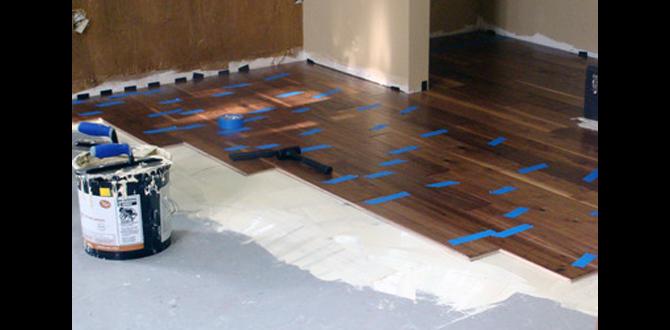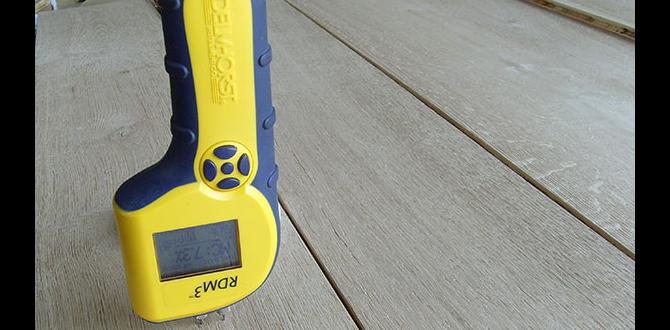Quick Summary
Replacing a trigger mechanism is a straightforward DIY task for most tools. Follow safety steps, identify the correct replacement part, and use your tool’s manual for a smooth process. This guide breaks down each step for successful trigger replacement.
Hey there, DIYers and woodworking friends! Jack Shaffer here, your go-to guy for all things nailers and tools.
Ever get that frustrating feeling when your nailer just won’t fire, or the trigger feels mushy and unreliable? It’s a common issue, and often, the culprit is a worn-out trigger mechanism. It can feel like a big hurdle to overcome, especially if you’re new to tool repair. But guess what? Replacing a trigger mechanism is usually much simpler than you might think!
With a little patience and the right guidance, you can get your tool back in working order quickly and save yourself the cost of a professional repair or even a new tool. This comprehensive guide will walk you through everything you need to know, step by step. We’ll cover safety first, finding the right parts, and the actual replacement process. Let’s get your tool firing like new again!
Table of Contents
Why Replacing a Trigger Mechanism is Necessary
Your tool’s trigger mechanism is the nerve center, the part that translates your intention into action. It’s a cluster of springs, levers, and electrical or pneumatic components that work together seamlessly. Over time, like any hardworking part, it can experience wear and tear.
Think of it like anything else that gets a lot of use – a car’s ignition switch, a keyboard key, or the trigger on your favorite water gun from childhood. Constant pressing, often with varying force, can lead to:
- Worn Springs: Springs lose their tension, making the trigger feel loose, unresponsive, or requiring excessive force to activate.
- Damaged Levers or Components: Small plastic or metal parts can break or bend due to impact, stress, or age.
- Electrical Issues (for electric tools): Contacts can become dirty, corroded, or worn, preventing signals from reaching the motor.
- Air Leaks (for pneumatic tools): Small seals can degrade, leading to inconsistent air flow and a weak trigger response.
Ignoring a faulty trigger mechanism isn’t just annoying; it can also be dangerous. An inconsistent trigger might cause unintended firing or failure to fire when you expect it to, leading to potential injuries or project delays. Replacing it is often the most cost-effective and efficient solution to restore your tool’s functionality and your peace of mind.
Understanding Your Tool’s Trigger Mechanism
Before you dive into replacement, it’s helpful to understand the basic components of a trigger mechanism. While designs vary slightly between different types of tools (like pneumatic nailers, electric drills, or electric saws) and manufacturers, the core principles are similar.
Pneumatic Nailer Trigger Mechanisms
For pneumatic nailers, the trigger is primarily a mechanical and pneumatic control. When you pull the trigger:
- A lever system is actuated.
- This lever often depresses a small piston or valve.
- This valve releases a controlled burst of compressed air from the tool’s internal air reservoir.
- This air then drives the piston that fires the nail.
- A spring returns the trigger to its resting position once released.
A common component here is the trigger valve, which is the heart of the mechanism. It’s responsible for precisely releasing the air.
Electric Tool Trigger Mechanisms
Electric tools, like drills, saws, or sanders, have trigger mechanisms that are essentially electrical switches. When you pull the trigger:
- It makes electrical contact.
- This completes a circuit, sending power to the tool’s motor.
- Many electric triggers are variable speed, meaning the further you pull the trigger, the more resistance there is, and the faster the motor spins. This is achieved through rheostats or electronic speed control modules.
- A spring returns the trigger to the off position when released.
The key component here is the trigger switch, which can range from simple on/off contacts to complex variable-speed electronics.
Safety Features
It’s crucial to remember that most modern tools incorporate safety features into their trigger mechanisms. For nailers, this is often a contact trip mechanism (the part that touches the work surface before the trigger is pulled) or a secondary safety trigger. For electric tools, it might be a lock-off button to prevent accidental startup. Understanding these will help you navigate the disassembly and reassembly correctly.
Safety First! The Most Important Step
Before we even think about touching a single screw, let’s talk safety. This is non-negotiable, always. Working on tools, especially those that can cause injury, demands respect and caution.
- Always disconnect the power source. For pneumatic tools, this means disconnecting them from the air compressor. For electric tools, this means unplugging them from the wall or removing the battery pack. Do this immediately and double-check that it’s disconnected.
- Wear safety glasses. Small springs, clips, or parts can fly out unexpectedly during disassembly. Protect your eyes!
- Work in a clean, well-lit area. You need to see what you’re doing and keep track of small parts.
- Consult your tool’s manual. Every tool is different. The manufacturer’s manual is your best friend for specific instructions, diagrams, and part numbers. If you don’t have a physical copy, search online for your tool’s model number plus “manual.” Many reputable manufacturers offer PDF downloads.
- Be aware of stored energy. For pneumatic tools, there might be residual air pressure in the tool even after disconnecting from the compressor. Safely discharge any pressure as per your manual’s instructions.
Taking these precautions ensures that your repair journey is safe and successful. Remember, the goal is to fix your tool, not to become part of a cautionary tale.
Gathering Your Tools and Parts
With safety covered, let’s assemble what you’ll need. Having everything ready before you start will make the process much smoother.
Essential Tools
Most trigger mechanism replacements require common tools found in any DIYer’s toolbox:
- Screwdriver Set: You’ll likely need Phillips head and possibly flathead screwdrivers in various sizes. Small, precision screwdrivers might be necessary for tiny screws on some models.
- Pliers: Needle-nose pliers are incredibly useful for grasping small springs, clips, or wires. Standard pliers might also be needed for slightly larger components.
- Allen Wrench Set (Hex Keys): Some tool housings are secured with hex screws.
- Socket Set/Wrenches: Less common for trigger mechanisms themselves, but might be needed to remove outer casings on some larger tools.
- Small Pick or Awl: Handy for gently prying or manipulating small parts, springs, or locating screw holes.
- Container for Parts: A small tray, magnetic dish, or even a few plastic cups to hold screws and small components so they don’t get lost.
- Damp Cloth: For cleaning parts and your workspace.
- Optional: Camera or Smartphone: Take pictures as you go! This is a lifesaver during reassembly.
Identifying and Ordering the Correct Replacement Part
This is often the trickiest part, but crucial for a successful repair. You need the exact trigger mechanism designed for your specific tool model.
Where to Find Part Numbers:
- Tool Manual: The exploded parts diagram in your manual is the best place to find the official part number.
- Manufacturer’s Website: Most tool manufacturers have a support or parts section on their website where you can enter your tool’s model number to find diagrams and order parts.
- Tool Service Centers: Local authorized repair centers can often help identify and order parts.
- Online Retailers: Many specialized tool parts websites sell OEM (Original Equipment Manufacturer) and aftermarket parts.
When ordering, make sure you have:
- The exact model number of your tool.
- The serial number (sometimes needed for specific production runs).
- The part number for the trigger mechanism assembly.
A table can help you keep track of needed parts:
| Item | Description | Source/Part Number | Quantity | Notes |
|---|---|---|---|---|
| Trigger Mechanism | Part number: XYZ-12345 | Manufacturer Website / ACME Tools Parts | 1 | Ensure it matches model XXX-YYY |
| Housing Screws (if needed) | Small Phillips head | Original tool | Set | Check condition before reassembly |
| Springs (if applicable) | Return spring | Part number: ABC-67890 | 1 | If original is damaged |
Double-checking is key. Ordering the wrong part means more delays and potential frustration. If you’re unsure, contact the manufacturer’s customer support directly. It’s better to ask than to guess!
Step-by-Step Guide to Replacing the Trigger Mechanism
Alright, you’ve got your tools, your replacement part, and you’ve reviewed your manual. Let’s get to work! We’ll cover a general process that applies to most tools, but always refer to your specific manual for exact steps and diagrams.
Step 1: Prepare Your Workspace and Tool
As mentioned before, ensure you’re in a well-lit, clean area. Place your tool on a stable surface. Disconnect the power source (unplug or remove the battery pack/air hose). If it’s a pneumatic tool, safely bleed any residual air pressure from the tool. This is essential for safety and to prevent parts from being ejected forcefully.
Step 2: Disassemble the Tool Housing
This is where you’ll start to see the inner workings. Most tools are held together by screws around the outer housing.
- Carefully locate all housing screws. They can sometimes be hidden under labels or rubber grips.
- Use the appropriate screwdriver or hex key to remove them.
- As you remove each screw, place it in your parts container. Note its location if screws are different lengths.
- Once all screws are removed, gently separate the housing halves. You may need to gently pry them apart with a plastic trim tool or a flathead screwdriver in designated seams, but be careful not to force it or damage the plastic. Some housings might have clips that need to be released.
Pro Tip: Take photos at this stage! Document how the housing comes apart. This is incredibly helpful for reassembly.
Step 3: Locate the Old Trigger Mechanism
With the housing open, you’ll see the internal components. Trace the trigger back to where it connects to the main mechanism.
For pneumatic nailers: You’ll typically see the trigger connected to a trigger valve assembly. This assembly might be a single unit or have a few key parts.
For electric tools: The trigger will be connected to a switch or electronic module. You might see wires leading to it.
Step 4: Remove the Old Trigger Mechanism
This step requires care and attention to detail. The exact method will vary by tool.
- Note electrical connections: If your tool has electrical wires connected to the trigger switch, take clear photos or make notes of which wire goes to which terminal. You might need to gently pull these off the terminals or unscrew them.
- Identify mounting screws or clips: The trigger mechanism will be secured in place. Look for small screws, retaining clips, or pins that hold it.
- Carefully remove securing hardware: Use your pliers or screwdriver to remove screws, pins, or release clips. Keep these in your parts container.
- Remove springs and linkages: Pay close attention to any springs or small linkages connected to the trigger. Note their orientation and how they are attached. Springs can be under tension, so handle them carefully. You might need needle-nose pliers to gently detach them.
- Extract the old mechanism: Once everything is detached, you should be able to carefully lift or slide the old trigger mechanism out.
Another helpful tip: If your trigger part number is located on the old mechanism itself, note it down before removing it entirely. Sometimes the part number is molded into the plastic.
Step 5: Install the New Trigger Mechanism
This is essentially the reverse of the removal process. Take your time and work methodically.
- Position the new mechanism: Carefully place the new trigger mechanism into its designated spot within the tool housing.
- Reattach springs and linkages: This can be the most fiddly part. Refer to your photos or manual. Gently reattach any springs, levers, or linkages to their correct positions on the new trigger and its mounting points. Ensure springs have the correct tension and are seated properly.
- Secure the mechanism: Reinsert any mounting screws, clips, or pins that hold the new trigger mechanism in place. Make sure it feels secure and doesn’t wiggle excessively where it shouldn’t.
- Reconnect electrical wires (if applicable): Carefully reattach any electrical wires to their corresponding terminals on the new switch. Ensure they are snug and properly seated.
If you’re having trouble getting a spring to seat, a small pick or awl can be useful for guiding it into place. Work slowly and deliberately.
Step 6: Reassemble the Tool Housing
Now, it’s time to put the tool back together.
- Align the housing halves: Carefully bring the two halves of the tool’s housing back together. Make sure no wires or components are pinched between them.
- Check for proper fit: Ensure the seams line up correctly and the housing sits flush.
- Replace housing screws: Start by threading in a few screws to hold the halves together. Then, go back and install all the screws. Tighten them until they are snug, but avoid overtightening, which can strip the threads or crack the plastic housing.
Again, refer to your photos to ensure all screws go back into their original locations.
Step 7: Test the Tool
This is the moment of truth!
- Reconnect the power source: Plug in your electric tool or connect your pneumatic nailer to an air hose (and ensure the air is turned on).
- Dry Fire (Safely!): For a nailer, point it at a scrap piece of wood in a safe direction and gently pull the trigger. For an electric tool, do the same with a scrap material or just with the bit/blade in the air.
- Check the trigger action: Does the trigger feel responsive? Does the tool operate as expected?
- Troubleshoot if necessary: If it still doesn’t work, don’t panic. Review the steps you took. Did you miss a connection? Is a spring out of place? Refer back to your manual and photos. Sometimes, a small adjustment is all that’s needed.
If you’ve followed the steps carefully and the tool still has issues, it might indicate a problem with another component, or perhaps the replacement part wasn’t fully compatible. In such cases, it might be time to seek professional help or consider if the repair is worth the continued effort.
Common Problems and Troubleshooting
Even with careful planning, minor hiccups can occur. Here are some common issues and how to address them:
Trigger Feels Stiff or Sticky
Cause: A spring is out of place, misaligned, or the new mechanism isn’t seated perfectly.
Trigger Not Resetting Properly
Cause: The return spring is not installed correctly, is too weak, or is obstructed.
Tool Doesn’t Power On (Electric Tools)
Cause: Electrical connection is loose, wrong wire attached to terminal, or the new switch is faulty.
Nailer Fires Intermittently or Weakly (Pneumatic Tools)
Cause:




